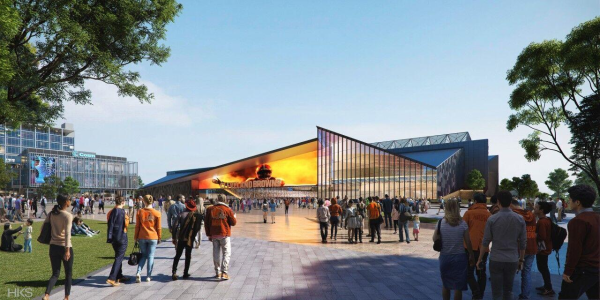
Stadium plan in neighboring Cleveland reignites dome debate
The Cleveland Browns plan for a potential $2.4 billion stadium with a dome in Brook Park has reignited years-long debates in Buffalo about a dome stadium.
The Cleveland Browns' plan for a new stadium has reignited years-long debates in Buffalo about a dome stadium.
The Browns released renderings last week for a potential $2.4 billion stadium with a dome in Brook Park, a suburb about 20 minutes outside Cleveland, where the city’s transit line begins and the airport is located. The lease for the team’s current stadium, which opened in 1999 downtown on the lakefront, expires after the 2028 season.
It has some Bills fans and supporters of the Buffalo dome idea asking, “Why couldn’t that have been us?”
After all, the two cities about three hours apart certainly have their similarities as Great Lakes regions with snow, wind and cold weather and residents known for having similar blue-collar DNA.

A rendering from a new stadium being proposed by the Cleveland Browns in Brook Park. Contributed image from HKS Architects
Let’s make one thing clear: The new open-air stadium in Orchard Park slated to open in 2026 is a done deal. But that hasn’t stopped the conversation about what could have been.
The Bills are building what is projected to be a $1.7 billion stadium in Orchard Park, across the street from the current Highmark Stadium on Abbott Road, despite calls from some fans to keep games from being played in the sometimes-challenging weather elements of Western New York.
John Cimperman knows both cities very well. Born in Ohio, he worked in marketing for professional sports organizations in Cleveland, before moving to Buffalo to do similar work. He now owns 42North Brewing Co.
He came away from his four-day visit last week to Cleveland a bit surprised that most Browns fans seem to favor the idea of a dome, even if it is not downtown. On the other hand, the Bills sold their new open-air facility based on the belief that the majority of fans preferred outside football for home games.
“It’s interesting how in two similar markets demographically, the views of the fans seem to be different,” Cimperman said.
That may have to do with the extra money area residents would have likely been asked to put into a dome stadium and the fewer results it would have yielded.
If the Bills built a dome, it would come at a significant cost, driving up the new stadium price tag closer to the one for the Browns proposed stadium, requiring potentially hundreds of millions of dollars in additional public funds from New York State and Erie County. Right now, the Bills are receiving at least $850 million in public funds. Project cost overruns are on the team.
A dome in Buffalo would certainly make the game-day experience more comfortable and likely benefit the current team’s offense, led by gun-slinging quarterback Josh Allen, but it would not have had the same payoff as in Cleveland.

Ongoing construction gives observers a view of the steel bones of the new Bills stadium. Joshua Bessex/Buffalo News
Buffalo is smaller in population, has fewer hotels and places to stay for visitors and a less developed infrastructure, making the area less likely to attract some of the sports events with the biggest economic impact, like the Super Bowl and NCAA Final Four.
On the other hand, a dome in the northeast Ohio region, anchored by an additionally proposed large-scale lifestyle and entertainment district, including retail, residential space and hotels, would likely bring some of the biggest events in the world and draw year-round activity.
The Browns have been asking for a 50/50 split in public and private money, which means they’re hoping for $120 million in public funds. The team’s vision also includes approximately $1 billion in privately funded phased development around the stadium. The team has not ruled out renovating the current stadium, which would require substantial improvements.
Still, building a dome stadium open year-round does go hand in hand with ancillary development. Even without the possibility of bringing some of the biggest events to the area, developers would be more apt to build when there’s a better chance for additional activity. The Bills have and may continue to struggle with that in Orchard Park because the stadium only hosts 10 to 20 events per year.
Cimperman used the example of Indianapolis and how the dome the Colts built there in 2008 made the area a hub for activity.
“It can become a catalyst for restaurants, hotels,” he said. “But, for us, that ship has sailed, so now it’s a matter of how we can leverage what we have to the best of our ability.”
The Tennessee Titans have broken ground on their $2.1 billion new stadium with a roof, which will also be the centerpiece for an entertainment district and is likely to bring large-scale opportunities to the burgeoning Nashville area.
There will be some new features to make the Bills new stadium a more comfortable experience, including a canopy roof that is expected to provide coverage for about 65% of the seats, radiant heat throughout the stadium and built-in wind confusion that will make it less blustery inside. But that’s little consolation to Buffalo dome supporters who want a weather-controlled environment every home game.

